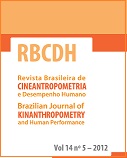Perfil de força isocinética dos rotadores dos ombros em jovens nadadores
DOI:
https://doi.org/10.1590/1980-0037.2012v14n5p545Resumen
Considerando que alguns estudos sugerem que desequilíbrios musculares dos rotadores dos ombros estão relacionados com dores e lesões na articulação e que não existem dados normativos para jovens nadadores, o objetivo deste estudo foi: i) caracterizar o equilíbrio e fadiga musculares bem como o perfil de força isocinética dos rotadores dos ombros em nadadores jovens; ii) comparar os resultados entre nadadores com jovens não praticantes; iii) contribuir para a criação de dados normativos de rácios unilaterais dos rotadores do ombro. Foi avaliada a força isocinética com ações concêntricas dos rotadores e respectivos rácios unilaterais (quociente entre torque dos rotadores externos e internos) em 60 nadadores (idade: 14,55 ± 0,5 anos; massa corporal: 61,16 ± 7,08 kg) e 60 não praticantes (idade: 14,62 ± 0,49 anos; massa corporal: 60,22 ± 10,01 kg). Com um dinamômetro isocinético (Biodex System 3), avaliou-se na posição de sentado (90º de abdução e de flexão do cotovelo), às velocidades angulares de 60º.s-1 e 180º.s-1. Os resultados dos índices de fadiga não revelaram diferenças entre grupos. Os nadadores apresentaram rácios unilaterais entre os 73,39±17,26% no membro dominante (MD) e 77,89±15,23% no membro não dominante (MND), para avaliações efetuadas a 60º.s-1; a 180º.s-1, obtivemos resultados entre 74,77±13,99% para MD e 70,11±14,57% para MND. Os nadadores apresentaram um maior desequilíbrio muscular, sendo a capacidade de produção de força dos rotadores internos (significativamente superior nos nadadores) o que os distingue do grupo de não praticantes.
Descargas
Publicado
Número
Sección
Licencia

Direitos Autorais para artigos publicados nesta revista são do autor, com direitos de primeira publicação para a revista. Em virtude da aparecerem nesta revista de acesso público, os artigos são de uso gratuito, com atribuições próprias, em aplicações educacionais e não-comerciais, desde que seja dada a atribuição. Esta obra foi licenciada com uma Licença Creative Commons Atribuição 4.0 Internacional - CC BY


